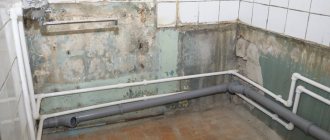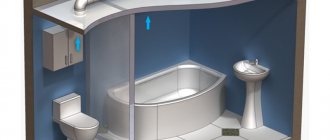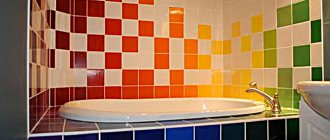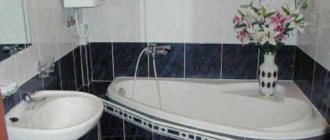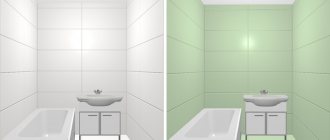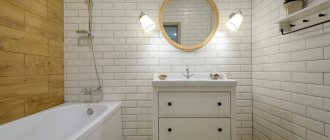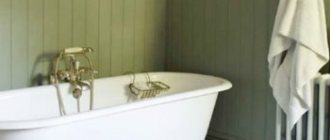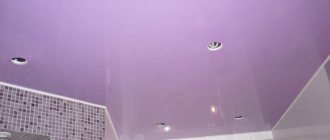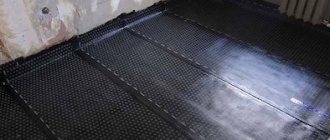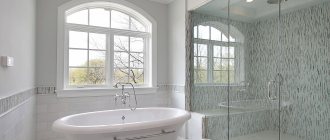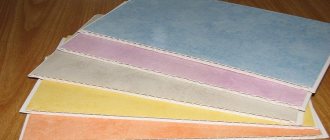The appearance of black, white and colored plaque on the walls of the bathroom signals the appearance of a fungus dangerous to health. To permanently remove mold from your bathroom, you need to use an effective fungicide.
To combat microscopic fungi, there are many folk recipes and ready-made chemicals. Before choosing the most suitable one, you should compare their composition, action and method of application. After using any product and solving the problem, preventive measures must be followed. In this case, the mold will forever “forget the way” to the bathroom.
What causes mold to appear?
As mentioned above, fungal spores settle and begin to develop in places with a high level of humidity (from 70%) and a temperature of at least 15°C . Such a place is the bathroom - a constantly closed and poorly ventilated room. Therefore, it is necessary to focus the entire fight against fungus on the causes of its occurrence, which include:
- heated towel rail malfunction;
- faucet malfunction or pipe leak;
- condensation that appears due to temperature changes;
- porous materials with which the bathroom is decorated can accumulate moisture;
- lack of hood.
It is very easy to notice the appearance of fungus - just look at the condition of the seams between the tiles (they will turn black), gray-black spots and small dots on the walls, as well as an unpleasant odor. In addition, it can even cause peeling of plaster and paint, damage to concrete coatings and finishing materials.
It is worth understanding that fungal pores can appear not only in the bathroom, but also in other rooms, while maintaining the ability to further spread. Fighting him is a very problematic matter. So it’s best to prevent the creation of conditions for its development if you don’t want to throw away money on another expensive repair.
Now let's look at ways to get rid of mold in the bathroom, depending on the degree of neglect.
How to destroy fungus forever?
Mold in the bathroom is eradicated in various ways. But before starting the fight, it is worth assessing the depth and severity of the fungal damage to the room. If the infection has covered a large surface of the wall and affected the wallpaper in the bathroom, then it is necessary to get rid of it and carry out a high-quality treatment of the room.
Simply washing off the fungus with water will not work. You need to act on defeat, otherwise the mold will not be removed. Professionals know how to get rid of the scourge: you need to carefully remove the affected layers of plaster from the ceiling with a spatula, remove the layer of paint or sealant and clean all areas, then dry the room thoroughly. Next, you need to treat the room with antifungal agents, strictly following the instructions; You may need to process the walls 2 times, with a short break.
Removing fungus at an early stage
The fact that there is a high level of humidity in the bathroom can be understood when black spots begin to appear. In this case, you urgently need to set up a ventilation system and start treating the walls. It’s better not to put this off for a long time, since the mold that has just appeared will be easier to destroy than later, when time passes and you are racking your brains over how to get rid of fungus in the bathtub.
After the surface has been cleaned of it, it should be thoroughly treated with hydrogen peroxide, vinegar essence or chlorine bleach. All these products can be found in stores. It is also recommended to use copper sulfate or a solution of concentrated bleach. But ideally, it would be to purchase specialized chemicals designed just for such cases. This will allow you to eliminate fungus in the bathroom at a more professional level and make prevention for the future. Among such products, it is worth highlighting a special antifungal spray that should be used to treat the air in the bathroom.
In the bathroom, fungus can appear in quite unexpected places. If you haven't used your shower head for a long time, you should treat it with vinegar to prevent it from becoming an incubator for mold. From time to time, disinfect all surfaces for preventive purposes.
Tips on how to remove fungus in the bathroom on and under tiles
If the tiles have been damaged by fungus, removing the plaque is not difficult. This is done using any available detergents and a sponge with a hard surface. But mold under the tiles will be more difficult to remove.
To make it easier to remove fungus on bathroom tiles, you need to use a special brush
To clean stubborn stains you will have to:
- Remove the grout and dry the walls with a hair dryer;
- After that, treat all connecting places with special substances, preferably several times;
- Then rub the seams again and cover them with an antiseptic.
After these steps, you can begin removing the tiles, and then scrub the walls and ceiling with a stiff brush. Apply antiseptic to all areas and leave to dry. To consolidate the result, everything can be repeated.
To dry the room, you can turn on a quartz lamp for several hours.
Fight against fungus at a progressive stage
If you were unable to remove the fungus at the stage of its formation, then it’s time to bring in the “heavy artillery.” First you need to find its source , namely the mycelium, since blackness is only the visible part of the problem, and its cause lies in the mycelium, where the development of the fungus occurs. Often it can be found behind plaster in voids. To remove mold, use a spatula. You should also remove the grout between the seams if it has also become black. If you notice a loose tile, it is recommended to dismantle it and check for the presence of fungus, and there is a 99% chance that it will be there.
And in order for you to understand how the fight against fungus in the bathroom should take place, familiarize yourself with the following procedure:
- it is necessary to thoroughly clean the areas affected by mold, while not forgetting about your health - you need to work in a respirator mask, rubber gloves and, preferably, glasses, since the waste products of the fungus are very dangerous;
- mold should be washed off with a sponge soaked in a solution of chlorine-containing detergents, but this is provided that it appears on a flat surface such as tiles. For additional effect, it is recommended to treat it again with special antiseptics;
- if fungus has formed on the grout, as mentioned above, it should be removed with a spatula and the seams between the tiles should be thoroughly dried with a hair dryer. After this, the joints are treated twice with an antiseptic. Then you can apply the grout again, first in an antiseptic solution;
- if mold appears under the tiles, it will also need to be dried with a hair dryer and treated with two layers of antiseptics. Re-gluing is carried out with ordinary building mixtures, to which an antiseptic should be added;
- If there is massive damage to the walls in the bathroom over an area of more than 2 m2, it is recommended to entrust the work to specialists who will analyze the fungus and select the most effective means and their concentration for this case.
As for the smell, it will go away only when the mold is removed. Upon completion of all work related to its neutralization, it is recommended to leave an open pack of soda in the bathroom , which absorbs unpleasant odors well. In addition, wipe all surfaces with it from time to time.
Having completed the work to eliminate fungus in the bathroom, you need to carry out timely maintenance of the ventilation shafts, and if small areas of mold reappear, carefully treat the surface of the walls. It is also recommended to carry out preventive treatment at least once a quarter.
How to get rid of mold in the bathroom
Removing fungus in the bathroom is not so easy. After all, sometimes even finding it is problematic. He can even hide under tiles. This occurs due to poor-quality preventative surface treatment before laying the tiles. In this case, there may be a need for global repairs.
Before removing mold from your bathroom, take the following precautions:
- Put on rubber household gloves.
- Use a respirator or dust mask, special glasses.
- Wear overalls or clothing that you won’t mind throwing away.
Open a window for ventilation or turn on the hood. Close the doors to the bathroom tightly, cover all the furniture with oilcloth.
To remove mold in the bathroom at the initial stage, it is enough to treat the location with an antiseptic. If fungal colonies have settled in hard-to-reach places - the seams between tiles, on the edges of the bathtub, in the shower stall, then you will have to completely wipe off the affected seam, disinfect it with an anti-fungal agent and cover it again. Before applying grout, be sure to dry the seam. Use a regular hair dryer. We recommend treating not only the area where the mold was located, but also the surrounding areas.
The chemical industry offers many effective drugs that can cope with mold in the bathroom:
- Atlas Mykos;
- Izohan Grzybostop;
- PS 50;
- Snowball;
- Fungicide;
- Boramon;
- Renogal;
- Domestos.
IMPORTANT!!! When using strong chemical anti-mold agents, carefully ensure that pets do not enter the bathroom - a cat or dog may inhale harmful fumes or damage their paws and respiratory organs (chemical burns from contact with the product).
It is quite possible to remove mold in the bathroom using folk remedies:
- Copper sulfate;
- Vinegar and soda are the best remedy for mold on walls;
- White;
- Ammonia;
- Hydrogen peroxide is an antiseptic for the bathroom;
- Grapefruit seed extract;
- Anthracene oil – antifungal oil for walls;
- Tea tree oil;
- Alcohol tincture of iodine.
As you can see from the list, mold repellents can be found in the medicine cabinet, in the kitchen cabinet and directly in the bathroom.
Folk remedies for mold have been tested for many years and with numerous successful results. But, due to the fact that the fungus is able to adapt to the most effective means, you should constantly check the usual places of its appearance and, if it spreads, change the methods of disposal.
Copper sulfate
Copper sulfate is a fairly effective remedy against fungus in the bathroom. It is freely available in hardware stores. To combat colonies, prepare a solution:
- 100 g of copper sulfate;
- 10 liters of water at room temperature;
- 100 ml table vinegar;
- Prepare the solution in a non-metallic container.
Walls and ceilings are treated using a spatula, sponge, and sandpaper.
Soda and vinegar
If the first signs of mold are noticed in the bathroom, then you can deal with it using table vinegar. This remedy for mold on bathroom walls works well against mildew that has not yet grown too much. The smell, of course, is pungent, but the bleach vapor is even stronger.
There are two ways to apply vinegar to surfaces affected by colonies:
- Using a sprayer;
- Rubbing in with a sponge.
Soda solution also successfully fights mold germs. In addition, soda has no odor, and if you treat the walls of the bathroom with soda without gloves, the skin of your hands will dry out a little, which can be easily corrected with cream. In order to wash the bathtub with soda and lemon, prepare a slurry of soda and citric acid (lemon juice) with the addition of liquid soap. It is recommended to apply this product with a sponge.
White
How else can you clean mold in the bathroom? Another popular folk remedy against fungus on walls is Belizna laundry bleach. There is no need to dilute the product, since the higher the concentration, the better. Bleach should only be used on hard, non-wet surfaces. You cannot apply it to wood or drywall - the material will be damaged.
To prevent mold, dilute ½ cup of bleach in 1 liter of warm water and apply with a brush, sponge or spray bottle. After some time (it is advisable to leave it for several hours for a more effective effect), the solution is washed off with plain water.
Ammonia
Housewives rub tiles and mirrors with ammonia until they shine. But it is also a wonderful antifungal agent. Dilute ammonia with water by half and wipe all surfaces affected by pathogenic colonies.
IMPORTANT!!! You should not try to enhance the anti-mold properties of solutions by mixing some incompatible ingredients, for example, “Belizna” and ammonia - a violent chemical reaction is accompanied by the release of a large amount of ammonia-containing gases. It is necessary to use only one product or alternately, after weathering the previous solution.
Hydrogen peroxide
The first aid kit must have a bottle of 3% hydrogen peroxide for first aid, but it can also be used as an antifungal agent. The advantage of peroxide (hydrogen peroxide) over other solutions is the absence of odor and disinfecting and antiseptic properties. In addition, hydrogen peroxide removes fungus not only from waterproof hard surfaces (tiles, brick, concrete), but also plastic and wood. But if the furniture or decoration is dark in color, then peroxide can lead to partial discoloration of the surface.
Grapefruit Seed Extract
The extract works well against fungus in the bathroom. It is enough to add 15 drops of liquid into a glass of water and spray it on the walls, floor, and in hard-to-reach places where mold spores often hide.
Anthracene oil
A substance such as anthracene oil is a fraction of coal tar, the active element is phenol. Sprayed oil on the floor, on tiles, along the seams between tiles, in a bathtub, in a shower stall protects against the spread of mold and its spores. At the same time, it is not washed off with water and remains active for a long time.
The only drawback of anthracene oil is its not very pleasant smell, which can be eliminated by following all the rules of ventilation and airing.
Tea tree oil
Unlike anthracene, tea tree oil has a rather pleasant smell, and is even used in aromatherapy treatments to normalize the functioning of the respiratory system. The oil can be bought at the nearest pharmacy or in a specialized store for those who like to take a steam bath.
In a half-liter jar of water, stir 2 teaspoons of tea tree oil and spray the resulting product over all surfaces of the bathroom. Unfortunately, this product is easily washed off with water, so we recommend spraying at night so that the solution has time to act and kill all fungal spores before the morning.
Iodine
For preventive purposes or when a small area of mold is initially detected, iodine can be used diluted in water. But not as a treatment agent, iodine can even “color” tiles and concrete, but place several containers with iodine solution around the bathroom. It is the evaporation that helps cope with the fungus. Camphor balls are successfully used instead of liquid.
Folk remedies for mold control
Traditional methods are suitable primarily for those people who are allergic to chemicals.
The easiest way is to sprinkle baking soda on the mold-affected surface and pour vinegar over it . Once the foam has settled, thoroughly wash the walls and other areas with warm water and soap.
The second method is more exotic because you will need tea tree oil for it. Dilute two teaspoons of it in two glasses of warm water and apply it to the tiles using a spray bottle. In this case, rinsing is not necessary.
And the last method involves preparing a solution of two parts hydrogen peroxide, four parts water, one boric acid and two parts table vinegar. After this, you need to thoroughly wipe the surface from mold.
How to prevent mold?
As you know, it is easier to prevent the cause than to fight it, and fungus in the bathroom is no exception. Even if you managed to rid yourself of this scourge once, failure to follow the simplest rules can cause it to reappear. Therefore, in order to save yourself from repeated waste of personal time, effort, and even more so money, it is recommended to adhere to the simplest recommendations:
- in the bathroom it is recommended to maintain humidity at 30%, and therefore you should think about buying a high-quality heated towel rail;
- the bathroom should be well ventilated and for this it is recommended to install a powerful fan in the hood, and after water procedures leave the doors open for a while;
- if you are doing a major renovation or just moving into a new apartment, then for the purpose of prevention it is recommended to pre-treat the walls with a special antifungal agent and only after that start laying tiles;
- carefully examine the pipes and plumbing to make sure there are no leaks;
- The cause of the appearance of fungus is also condensation on the pipes, and therefore it is recommended to install plastic pipes;
- joints where moisture is expected to accumulate must be treated with sealant;
- It is best to dry clothes in other rooms (for example, on a balcony, if you have one) or on the street. If this is not possible, then dry only in minimal quantities;
- Check your toothbrush cups regularly and do not allow water to stagnate in them;
- It is recommended to install a “warm floor” system in the bathroom;
- if necessary, insulate the walls by first sealing existing cracks.
Remember that if you ignore the exact moment the fungus appears, it can ultimately become a very, very serious problem , not only for you, but also for your neighbors, since mold causes such serious diseases as asthma and candidiasis with allergies. Therefore, it is recommended to combine methods of prevention and control of mold in order to get rid of this infection once and for all. The most important thing is to prepare properly and choose the appropriate tools that will help you in the current situation. And of course, be careful, especially when removing mold and subsequent chemical treatments.
How to clean fungus in the bathroom using antiseptics
To remove fungus from the bathroom, you can use products specially designed for this.
When making a purchase, pay attention to the specific purpose of the drug. It should specifically destroy mold, and not be used for prevention.
Antifungicides can perfectly fight not only mold, but also destroy pathogenic microbes and bacteria. Even some types of insects are afraid of them.
To wash off the fungus, all you need to do is purchase a special chemical and a sponge.
Products that have proven effective in combating fungus:
- “Antifungal” and “Antifungal-anti-mold” are a completely non-toxic and safe drug for health. Can be used on any surface, no matter what it is: wood, plaster or concrete.
- "DALI" - can be used as a prophylactic agent, or can very effectively fight fungus. It is especially useful for wooden surfaces, as it “knows how” to prevent the appearance of bugs and other unwanted “guests” in the wood.
- “Mill Kill” - this emulsion is perfect for finely porous surfaces, as well as for treating areas where water flows. Before using the product, large areas of mold should be removed with a stiff brush, and what remains should be washed off with a cloth.
- “Isocide” is an excellent antifungal agent that destroys many dangerous microorganisms. Can be used for prevention.
With the help of such drugs, the fight against mold can be very successful.
